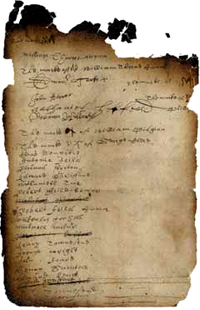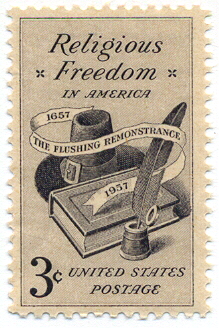Drawing The Line Between Church And State
A Closer Look At The Long History Behind Politics and Religion In America
Dec. 23, 2007
(CBS) "In God We Trust" is right there on all our coins and currency. To find the phrase "Wall of Separation," however, you must go not to the Constitution or the Bill of Rights, but to a letter President Thomas Jefferson wrote to Connecticut Baptists in 1802. His words have guided us ever since, but what, in practical terms, do they mean? Our Cover Story is reported now by Martha Teichner:
Eleven days and counting before their state nominating caucuses, it's understandable that some Iowa Republicans may be having trouble separating politics and religion.
The battle between Mitt Romney, the Mormon, and Mike Huckabee, the Baptist preacher, has defined the race.
Eleven days and counting before their state nominating caucuses, it's understandable that some Iowa Republicans may be having trouble separating politics and religion.
The battle between Mitt Romney, the Mormon, and Mike Huckabee, the Baptist preacher, has defined the race.
But even the possibility that a candidate's brand of faith could become a kind of presidential litmus test worries as many, if not more, Americans than it reassures - among them, Jon Meacham, editor of Newsweek.
"We are veering very close to violating the article in the Constitution that says, there should be no religious test for federal office," Meacham told Teichner.
Meacham is the author of " American Gospel," an attempt to put the tension between God and politics in historical perspective.
"We are veering very close to violating the article in the Constitution that says, there should be no religious test for federal office," Meacham told Teichner.
Meacham is the author of " American Gospel," an attempt to put the tension between God and politics in historical perspective.
| American Gospel: God, the Founding Fathers, and the Making of a Nation |
 |
"You have 46% of Evangelicals, in a poll that Newsweek did in Iowa, saying that Romney's Mormonism makes them less likely to vote for him," said Meacham. "That, in and of itself, is a very dangerous battle to have because it pushes religious affiliation to the center of debate in a country that has done very well when it has kept that kind of religious debate to the sides, or off the table altogether."
The living embodiment of that notion of separation is the neighborhood of Flushing, in the New York City borough of Queens.
Here you'll find every nationality imaginable - every religion. Within a few blocks, there are churches, a Quaker meeting house, Buddhist temples, synagogues, a mosque. As a sign of how mixed-up everything is, in front of the Queens public library, the Christmas tree and the Menorah were sponsored by the Chinese Businessmen's Association."

(CBS)
All of which makes what's inside that much more remarkable. It's called the Flushing Remonstrance (pictured, left) , on loan from the New York State Archives, signed December 27, 1657 - 350 years ago this week. It is a bold, historic declaration of religious freedom.
Professor Kenneth Jackson, who teaches New York history at Columbia University, described the significance of the remonstrance:
"This is one of the really great documents of American history that's preserved by the archives. It's the first thing that we have in writing in the United States where a group of citizens attests on paper and over their signature the right of the people to follow their own conscience with regard to God - and the inability of government, or the illegality of government, to interfere with that."
In 1657, Flushing was a farm village, and like Manhattan, part of New Netherland, a Dutch colony governed by Peter Stuyvesant. Stuyvesant persecuted followers of religions other than his own Dutch Reformed Church. When he barred Quakers from Flushing, thirty local citizens, none of them Quakers themselves, petitioned Stuyvesant, claiming the ban violated Dutch custom.
"It's just elegantly and eloquently written," Jackson said. "They say, 'We desire, therefore, in this case, not to be judged, least we be judged. Neither to condemn, lest we be condemned, but rather let every man stand and fall to his master.'"
Professor Kenneth Jackson, who teaches New York history at Columbia University, described the significance of the remonstrance:
"This is one of the really great documents of American history that's preserved by the archives. It's the first thing that we have in writing in the United States where a group of citizens attests on paper and over their signature the right of the people to follow their own conscience with regard to God - and the inability of government, or the illegality of government, to interfere with that."
In 1657, Flushing was a farm village, and like Manhattan, part of New Netherland, a Dutch colony governed by Peter Stuyvesant. Stuyvesant persecuted followers of religions other than his own Dutch Reformed Church. When he barred Quakers from Flushing, thirty local citizens, none of them Quakers themselves, petitioned Stuyvesant, claiming the ban violated Dutch custom.
"It's just elegantly and eloquently written," Jackson said. "They say, 'We desire, therefore, in this case, not to be judged, least we be judged. Neither to condemn, lest we be condemned, but rather let every man stand and fall to his master.'"
Peter Stuyvesant, no man to be trifled with, fined the petitioners and threw them in prison until they recanted - but there's more.
An important part of this story is the role played by a man named John Bowne, who lived here. Bowne allowed the Quakers to meet in his home. He was arrested, jailed, and sent to Holland for trial. The outcome was not what Peter Stuyvesant expected - Bowne was exhonerated.
And the principles set forth in the Flushing Remonstrance - essentially, freedom of worship and the separation of church and state - became practice.
"It didn't just come out of thin air, the First Amendment to the Constitution. We believed this already, in 1791, so it could become the cornerstone of the Bill of Rights," Jackson said.
Remember, most of the original 13 colonies had established churches and actually taxed citizens to support them. The end of that led to an explosion of religious fervor.
"In other words," Teichner asked Jon Meacham, "the separation of church and state enables the tolerance of someone else's religion?"
"Absolutely," Meacham agreed. "The separation of church and state is like oxygen to the fire of religious liberty."
So if you thought the tug-of-war between religion and politics is something new, think again.
"Religion has always been a weapon in the political arena," Meacham explained. "In 1800, there were advertisements that said you could have Jefferson and no God … or Adams and God." (
"It didn't just come out of thin air, the First Amendment to the Constitution. We believed this already, in 1791, so it could become the cornerstone of the Bill of Rights," Jackson said.
Remember, most of the original 13 colonies had established churches and actually taxed citizens to support them. The end of that led to an explosion of religious fervor.
"In other words," Teichner asked Jon Meacham, "the separation of church and state enables the tolerance of someone else's religion?"
"Absolutely," Meacham agreed. "The separation of church and state is like oxygen to the fire of religious liberty."
So if you thought the tug-of-war between religion and politics is something new, think again.
"Religion has always been a weapon in the political arena," Meacham explained. "In 1800, there were advertisements that said you could have Jefferson and no God … or Adams and God." (
Meacham cited another example: "In the Civil War, President Lincoln was presented with a proposed amendment to the Constitution to declare our allegiance to independence and Jesus … and in a brilliant parliamentary move, he referred it to a Congressional committee from whence it never emerged."
And another example, "Theodore Roosevelt, in 1908, was defending William Howard Taft, who was a Unitarian being attacked by William Jennings Bryan's supporters who were evangelicals who believed that Unitarians were not Christian."
And of course, lately, Teichner observed, we've been reminded of John F. Kennedy's famous speech.
On September 12, 1960, Kennedy said, "I believe in an America where the separation of church and state is absolute. Where no Catholic prelate would tell the President, should he be Catholic, how to act, and no Protestant minister would tell his parishioners for whom to vote."
Kennedy's self-defense to Houston ministers was that year's chapter in a long history ... Mitt Romney's speech was this year's.
In his speech , Romney said, "the founders proscribed the establishment of a state religion, but they did not countenance the elimination of religion from the public square. We are a nation under God, and in God, we do indeed trust."
The two speeches, 47 years apart, show how the conversation about what Jefferson called the "wall of separation" has evolved.
"Americans have tested that wall in every possible way," Meacham told Teichner. "We've run trucks up against it, we've thrown firecrackers at it, and the wall has stood pretty strongly. And it requires, I think, constant vigilance."
Because, as history and the First Amendment tell us, the relationship between government and religion is as fragile as it is strong.









Comments
Post a Comment